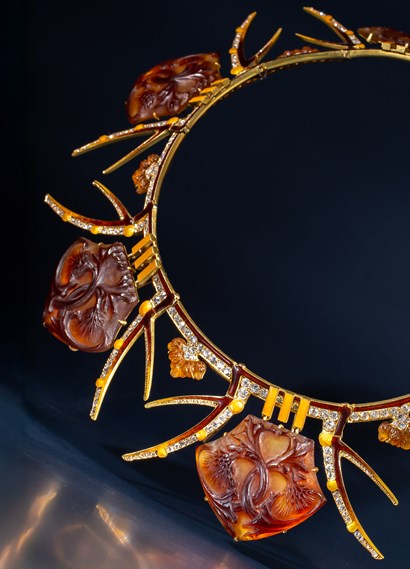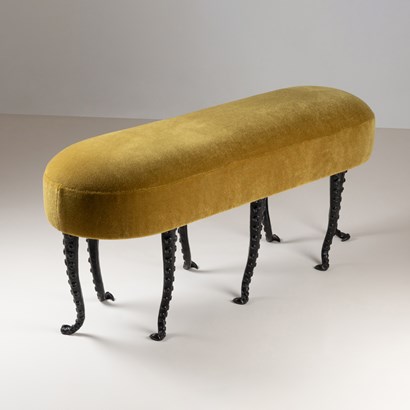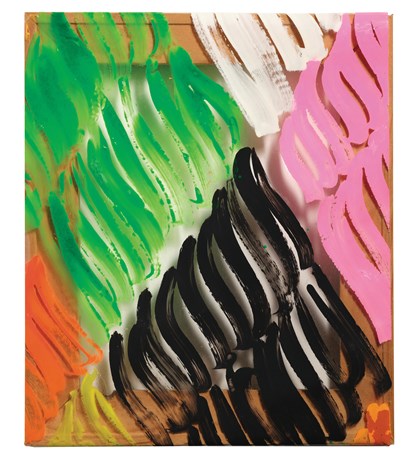This section will be available this Autumn.

Kunsthaus Kende
Satoshi Hara (Japan, Yokohama, 1962) Flower vase with inlaid Chrysanthemum design (mujinagiku) Ishikawa, 2018 Gold, silver and iron H 18 cm - Ø 20 cm Provenance: artist’s estate Satoshi Hara, who was born in Yokohama, Kanagawa Prefecture in 1962, specialises in creating hammered metalworks embellished with intricate and labour-intensive decorations in gold and silver. This highly developed inlay technique makes the decorations appear as if they were drawn with a thin pen. The artist has created his own technique, which he calls ‘Nanako Zogan.’ With this technique, he is able to inlay patterns into the vessels using 0.3 mm-thick silver wires. Each individual line is created in five different steps. One piece of work contains an average of 50 metres of silver wire, meaning that the artist has to work with approximately 200 metres of silver wire throughout the various stages. There is no room for error in this highly complex and time-consuming process, since it is impossible to rectify any mistakes. The artist has been teaching metalworking at Kanazawa College of Art, Department of Craft, since 2003. His work can be found in numerous museums in Japan and abroad.
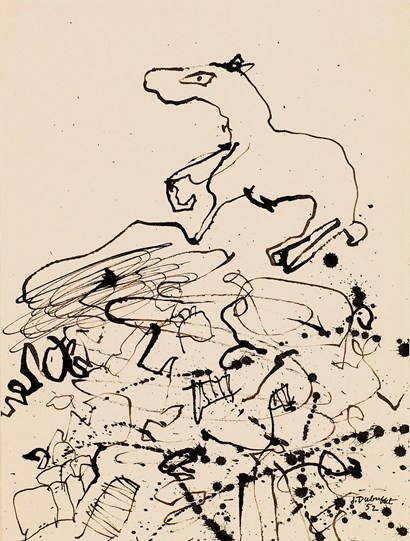
Galerie des Modernes
jean dubuffet
Jean Dubuffet (Le Havre 1901-1985 Paris) Terrain au Cheval 1, 1952 Indian ink (calame) on paper 30 x 22.5 cm Signed and dated lower right 'J. Dubuffet 52' Provenance: Pierre Matisse Gallery, New York, USA; Acquavella Modern Art, Reno, USA; Andrew and Christine Hall collection, Connecticut, USA; private collection, France; private collection, Belgium Literature: Max Loreau, Catalogue des Travaux de Jean Dubuffet, fascicule VII, Tables paysagées, paysages du mental, pierres philosophiques, Les Éditions de Minuit, Lausanne 1979, descr. and repr. on p. 109, n° 169 Exhibitions: Miro: early drawings collages 1919-1949 - Dubuffet: early drawings collages 1943-1959, Pierre Matisse Gallery, New York, November-December 1981; Dubuffet-Miro: selections from the Acquavella collection, Nevada Museum of Art, Reno, July-September 1997
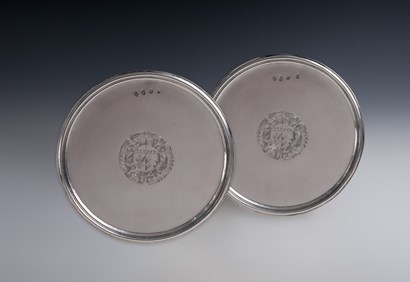
Kunsthaus Kende
Pair of Queen Anne tazze John Bache, London, 1703 Engraved Britannia silver Ø 23 cm, H 7 and 6.9 cm 513.1 gr and 504.8 gr Provenance: private collection, North America Standing on a central round foot, with moulded rim to the top side. The centre depicting an engraved coat of arms commemorating a marriage between two noble families. Outstandingly preserved and rare pair of Queen Anne tazze without repairs and showing their original preserved surface.
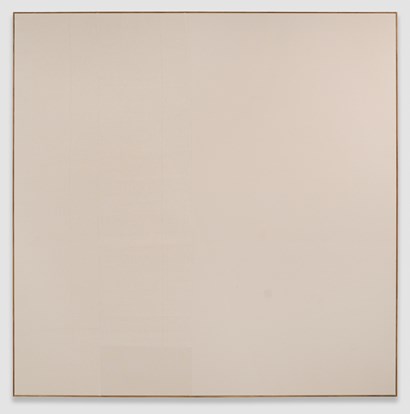
De Brock
ethan cook
Ethan Cook (USA, Texas 1893) Untitled, 2014 Hand woven cotton canvas and industrial canvas, framed 193 x 193 cm Provenance: the artist's studio, Brooklyn, NY, USA; T293 Gallery, Rome, Italy; private collection, Europe; Phillips, London, 26 June 2018, lot 276; private collection, UK; Phillips, London, 5 December 2018, lot 71; De Brock, Knokke, Belgium (acquired at the above sale)
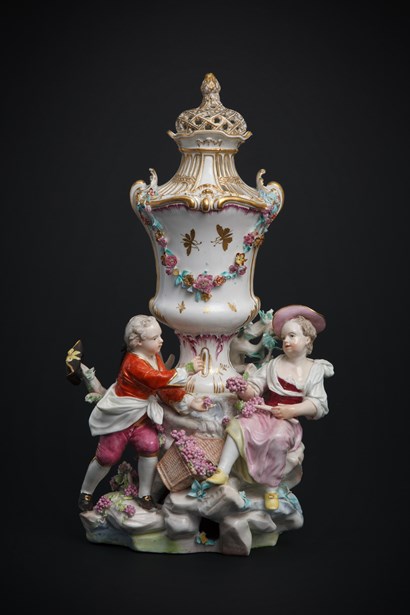
Art et Patrimoine - Laurence Lenne
Potpourri vase in polychrome porcelain Tournai porcelain, second period, 1763-1775 H 36.5 cm Rare potpourri vase in soft-paste, polychrome Tournai porcelain. At its base, it depicts a gallant offering grapes to his lady Provenance: former du Bois de Roest collection Literature: a similar piece is published in Lucien Delplace, Considérations sur les porcelaines de Tournai, p. 25, plate 3; and in Soil de Moriamé & Delplace, La Manufacture Impériale et Royale de Porcelaine de Tournay, 1937, p. 341, n° 645, plate 79

Philippe Heim
andré maire
André Maire (Paris, 1898-1984) Vue de Segovie, circa 1940 Oil on canvas 163 x 227 cm Signed lower right Certificate of authenticity issued by Philippe Heim Provenance: the artist's family Literature: André Maire (1898-1984), L'itinéraire décoratif d'un peintre voyageur, Éd. Gallimard, 16 October 2008, repr. p. 89 Exhibition: André Maire (1898-1984), L'itinéraire décoratif d'un peintre voyageur, Roubaix, La Piscine, 18 October 2008 to 1 February 2009
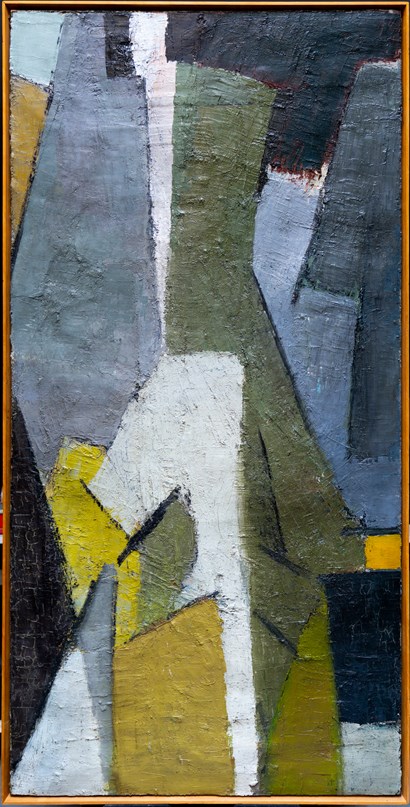
CKS Gallery
nicolas de stael
Nicolas de Staël (Saint Petersburg 1914-1955 Antibes) Composition, 1949 Oil on canvas 200 x 100 cm Provenance: private collection of the artist Literature: Françoise de Staël, Nicolas de Staël, Catalogue Raisonné de l'oeuvre peint, Paris, 1997, n° 203 Exhibitions: Hôtel de Caumont, Aix-en-Provence, 27 April-23 September 2018, Nicolas de Staël en Provence; Château Grimaldi d’Antibes, 17 May-7 September 2014, exhibition La figure à nu, hommage à Nicolas de Staël; MuMa – Musée d’Art Moderne André Malraux, Lumières du Nord, Lumières du Sud, 7 June-9 November 2014; Académie Royale des Beaux-Arts de Bruxelles, Belgium, 2012, for the 300th anniversary of the Académie Royale where de Staël studied from 1931 to 1934, 9 May-2 June 2012; Fondation Gianadda de Martigny, Switzerland, retrospective of the work of Nicolas de Staël, 18 June-21 November 2010; Centre Pompidou, Nicolas de Staël 1945-1955, Paris, 12 March-30 June 2003; Musée d'Art Moderne, Paris, Retrospective Nicolas de Staël, 15 September 2023-21 January 2024; Fondation de l’Hermitage, Lausanne, Nicolas de Staël Exhibition, 9 February-9 June 2024
_AristideMaillol_T638974992935545933.jpg?width=410&height=2000&qlt=90&scale=both&mode=max&format=jpeg)
Galerie Dina Vierny
aristide maillol
Aristide Maillol (Banyuls-sur-Mer, 1861-1944) Léda, 1901-02 Bronze H 28.3 cm Artist's monogram (on the back of the base) Ambroise Vollard edition from 1902 Foundry Florentin Godard, executed between 1907 and 1937 Provenance: private collection, New York; private collection, London: Galerie Dina Vierny, Paris (acquired from the above in 2025) Litrature: W. George, Les albums d'art Druet, vol. II, Maillol, Paris, 1927, another cast illustrated; J. Rewald, Maillol, Paris, 1939, p. 166 and another cast ill. pp. 110-111 (dated 'circa 1902'); W. George, Aristide Maillol, Berlin, 1965, pp. 137 & 232, another cast ill. p. 137; W. George, Maillol et l'âme de la sculpture, Neuchâtel, 1977, p. 128, another cast and terracotta version ill. pl. 139; B. Lorquin, Aristide Maillol, London, 1995, p. 52, another cast ill. p. 53

Virginie Devillez Fine Art
gustave de smet
Gustave De Smet (Ghent 1877-1943 Sint-Martens-Latem) Nu couché, 1928 Pencil, pastel and oil on paper 35 x 43 cm Signed lower right 'Gust. De Smet' Provenance: Walter Schwarzenberg, Brussels (Georges Giroux sale, Brussels, 1-2 February 1932, lot 43); Tony Herbert, Kortrijk; private collection, Belgium (by descent to the present owner) Literature: Piet Boyens, Gust. De Smet. Chronicle et Analysis of the Work, Antwerp, Fonds Mercator, 1989, CR 744 (p. 386); The Tony Herbert Collection, Deurle, Museum Dhondt-Dhaenens, 2011, p. 39 (ill.) Exhibitions: Brussels, Galerie Le Centaure, Gust. De Smet, 1928, cat. n° 69; Brussels, Galerie George Giroux, Gust. De Smet, 1929, cat. n° 160; Luxembourg, Musée d’Art et d’Histoire; Tony Herbert Collection, 1963-1964, cat. n° 38
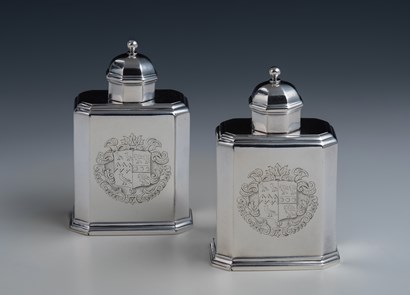
Kunsthaus Kende
Pair of George I Britannia silver tea caddies John Farnell, London, 1720 Engraved sterling silver H 12.5 cm 240.3 g and 237.4 g Provenance: private collection, North America The smooth, octagonal body merging into the correspondingly smooth shoulder. The lid finished with a twisted baluster. The base, which can be pulled out for filling, is only marked with a maker’s mark, the lid is unmarked. The bodies are hallmarked on the underside of the back. The contemporary coat of arms engraved on the front commemorates the marriage of a gentleman of the Dove family (who were based in East Burgholt in the county of Suffolk) and a lady of the Pierse family (whose family was based in Alston in the county of Warwickshire). An attractively preserved, early Britannia silver pair of tea caddies with a beautifully preserved, original surface.
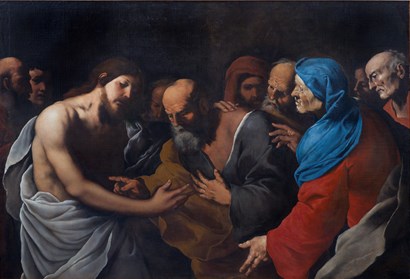
Hartford Fine Art - Lampronti Gallery
Francesco Fracanzano (Monopoli 1612-1656 Naples) The incredulity of Saint Thomas Oil on canvas 143 x 205 cm Literature: R. Causa, La pittura del Seicento a Napoli. Dal naturalismo al barocco, Naples, 1972, S. 976, n° 74; G. De Vito, Fracanziano’s periphrasis in XVII century Neapolitan studies, 2003/2004, pp. 104-105, fig. 2; N. Spinosa, XVII c. paintings in Naples, from Caravaggio to Massimo Stanzione, Naples 2010, p. 281 cat. n° 212; A. Della Ragione, Francesco Fracanzano, 2011, p. 10, fig. 23; N. Spinosa, Da Artemisia a Hackert. La collezione di un antiquario, exh. cat., Reggia di Caserta, Foligno 2019, cat. 9, pp. 18-19; N. Spinosa, Il Maestro degli Annunci ai pastori e i pittori del 'tremendo impasto' (Napoli 1625-1650), Rome 2021, cat. C5, p. 193 (quoting further literature: Cairo, 2011, pp. 203-210. Forgione, p. 233, fig. 12) Exhibition: Da Artemisia a Hackert. La collezione di un antiquario, Reggia di Caserta, 2019-2020
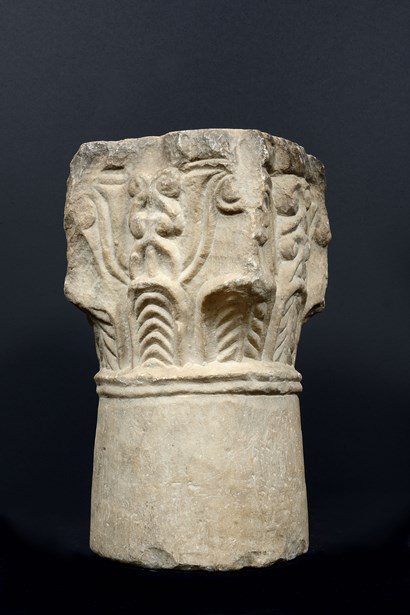
Mearini Fine Art
Capital with column from a Ciborio or Pergula Rome, late 8th-early 9th century White marble H 41 x Ø 20 cm Provenance: formerly in the collection of Elda Francia Gasparrini in Rome Literature: U. Broccoli, Marmi tardo antichi di una collezione privata a Roma, LV 1979, pp. 183-199, ill. p. 193 fig. 10
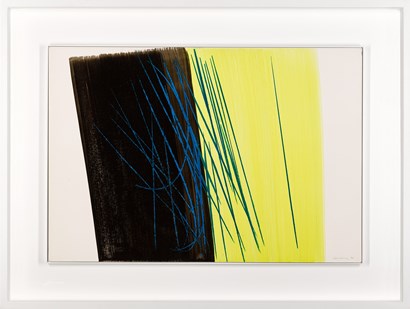
Samuel Vanhoegaerden Gallery
Hans Hartung (Leipzig 1904-1989 Antibes) P1971-20, 1971 Crayon and acrylic on baryta board 50 x 73 cm Signed and dated lower right This work is registered in The Hans Hartung and Anna-Eva Bergman Foundation archive with number P1971-20 and will be included in the forthcoming catalogue raisonné of Hans Hartung Provenance: Galerie Ludorff, Germany; Sotheby's London, July 2020; private Collection, Brussels; acquired from the above by the present owner
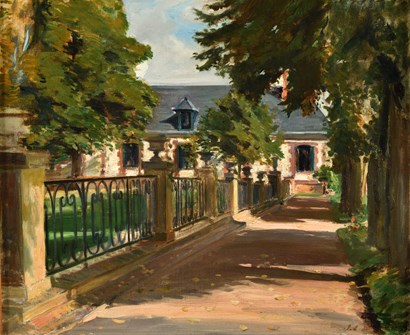
Galerie Alexis Bordes
jacques-emile blanche
Jacques-Emile Blanche (Paris 1861-1942 Offranville) View of a longère at the end of a tree-lined path, near Offranville Oil on canvas 38.3 x 46.2 cm Signed lower right: J E Blanche Certificate of authenticity by Mrs. Jane Roberts, a specialist on the artist Provenance: private collection, France Literature: Jane Roberts, Jacques-Émile Blanche, Paris: Gourcuff-Gradenigo, 2012; Mireille Bialek, Michel Ciry, Félicien Cacan, Jacques-Émile Blanche à Offranville: peintre-écrivain, Offranville: Mairie d’Offranville, 2006
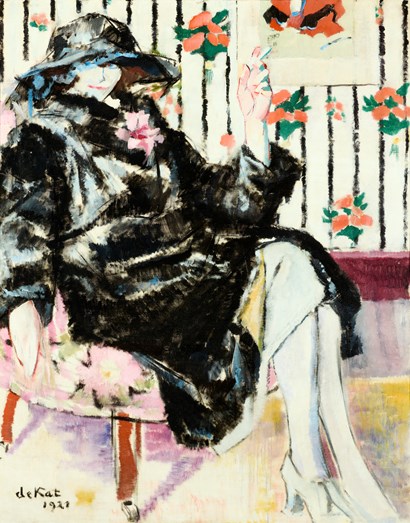
Galerie Raf Van Severen
anne-pierre de kat
Anne-Pierre De Kat (The Netherlands, Delft 1881-1968 La Frette-sur-Seine, France) Femme à la cigarette, 1921 Oil on canvas 102 x 80 cm Signed bottom left Provenance: private collection, Knokke-Heist Literature: Paul Caso, Anne-Pierre De Kat, Une vive intelligence visuelle, Les Editeurs d'Art Associés Exhibition: Guillaume Campo, Meir 47-55 Antwerpen, Exposition n° 121 (label at the back)
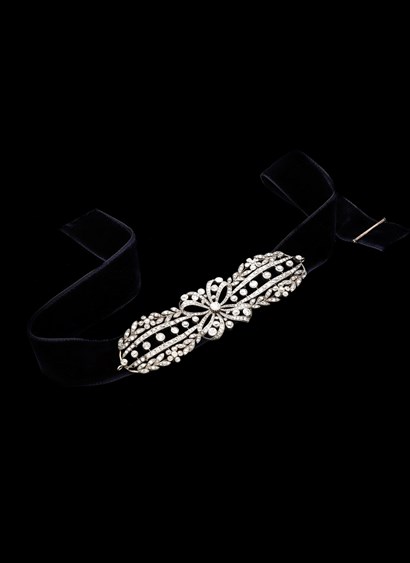
Pauline's Jewellery Box
Belle Epoque diamond tiara necklace, circa 1905 Platinum and diamonds Provenance: private collection, London An important Belle Epoque diamond tiara necklace, set with old European & rose cut diamonds. The estimated total diamond weight is approximately 12.00 carats. Estimated colour H-I on average. Estimated clarity VS-SI on average. The diamonds are bright & lively, mounted in platinum.

Galerie Bernard De Leye
Umbilicated dish and gadrooned basin in enameled copper Venise, circa 1500-1530 Ø 33 cm Provenance: collection Messel, Darmstadt; collection Ludwig and Anne Messel, London; collection Leonard and Maud Messel, London until 1953; Galerie Kugel, Paris; private collection, Switzerland Literature: Les cuivres émaillés dits Vénitiens, Corpus des œuvres en collections publiques et privées, Silvana Editoriale, 2018, Volume II, n° 34, p. 92 Twelve convex, curved white gadroons with blue highlights on a green background. This enamel production in Venice spans over a very short period within Venetian Decorative Arts. The basin is adorned with two rows of 24 concave, curved gadroons, then with scale-like motifs. The entirely blue reverse is richly decorated with gilded patterns.
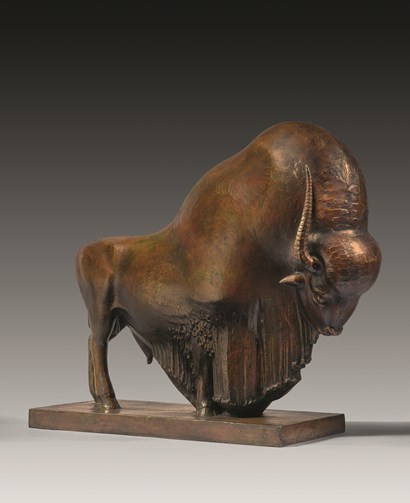
Galerie Nicolas Bourriaud
jacq orlande sinapi
Jacq Orlande Sinapi (Marseille, 1911-1989) Bison, circa 1940 Bronze with nuanced brown patina Cast by Leblanc-Barbedienne and bearing the foundry's stamp H 50 x W 57 x D 21 cm Signed ‘Jacq Orlande Sinapi’ Only two pieces known to date Provenance: private collection, France
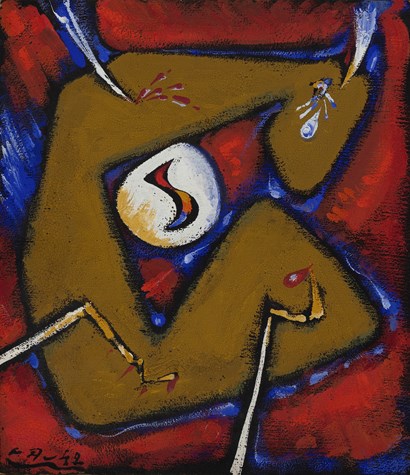
DIE GALERIE
andré masson
André Masson (Balagny-sur-Thérain 1896-1987 Paris) La victime, 1942 Gouache and sand on wood 37.8 x 32.8 cm Monogrammed and dated lower left Provenance: the artist’s studio; Galleria Studio Due Ci, Rome Literature: Masson: Massaker, Metamorphosen, Mythologien. exh. cat. Kunstmuseum Bern, Bern 1996, p. 39; André Masson. Un Combat, exh. cat. Musées de la Cour d'Or, Metz 1999, p. 39, 181; André Masson. La mémoire du monde, exh. cat. DIE GALERIE, Frankfurt am Main 2025, p. 43. Exhibitions: Masson: Massaker, Metamorphosen, Mythologien. Kunstmuseum Bern, 1996; André Masson. Un Combat, Musées de la Cour d'Or, Metz, 1999; André Masson. Zwischen Welten – Entremondes, Kunstsammlungen Chemnitz, Chemnitz, 2019-2020; André Masson. La mémoire du monde, DIE GALERIE, Frankfurt am Main, 2024-2025





 NEWSLETTER
NEWSLETTER
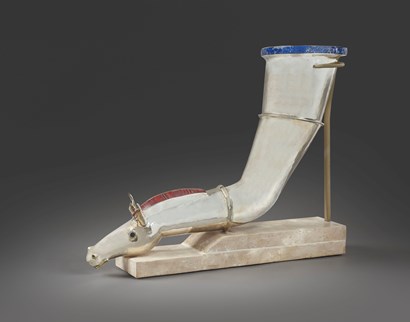

__T638930935598121241.jpg?width=410&height=2000&qlt=90&scale=both&mode=max&format=jpeg)

